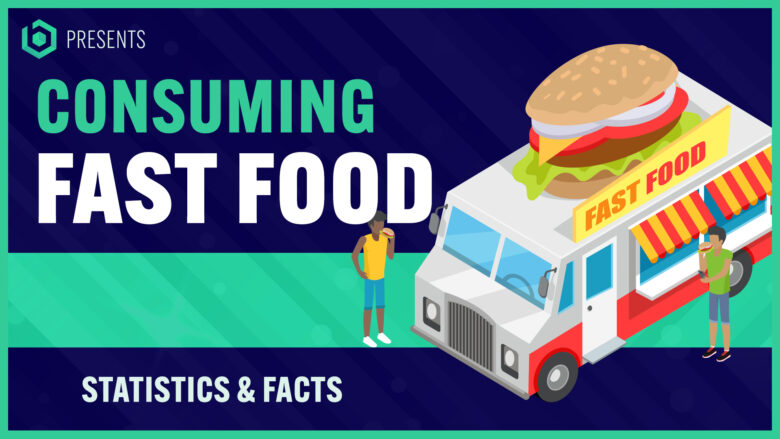Fast food is a love-hate relationship that we all have. On the one hand, it’s quick, convenient, and delicious. On the other hand, it’s often criticized for being unhealthy and contributing to America’s obesity epidemic.
But let’s face it, fast food has been a staple in our daily lives for decades and isn’t going anywhere anytime soon.
So, let’s dive into the world of burgers, fries, and shakes and uncover some surprising fast food consumption statistics and facts.
Get ready to be amazed and maybe even question your next drive-thru decision.
Money Spent on Fast Food Statistics (Editor’s Choice)

Let’s go over some basic fast food and money statistics so you can learn about the physical and economic benefits and risks associated with fast foods.
- In a year, one person spends nearly $1200 on fast food.
- Americans spent more than $200 billion on fast food in 2021.
- The average American spends $70000 in their lifetime.
- On any given day, 50 million Americans consume fast food.
- The global fast-food market is estimated to be worth 931.7 billion dollars.
- Once a month, 80 percent of Americans visit a fast-food restaurant.
- Fast food is consumed once a week by 20% of the population.
- Fast food meals three or more times per week by 23% of US adults.
- Fast food is consumed daily by 34% of children aged 2 to 19.
Almost everyone in the United States eats fast food at least once a month, if not more frequently. Fast-food customers spend more than 275 billion dollars worldwide on fast food. Out of this total global consumption, fast-food consumer expenditure in the United States accounts for 50 billion dollars per year. That is to say, Americans spend 18% of all fast-food spending worldwide on their favorite fast-food restaurants.
30 Fast Food Statistics That Left Us Speechless
1) Compared to 41% of preschool children exposed to TV ads for such products, 43 percent of preschool children ate products from restaurants they saw on TV ads.
In this study, preschool children were exposed to fast food television advertisements simultaneously with their parents for three different brands: McDonald’s, Wendy’s, and Subway.
After calculating each child’s exposure to advertisements and comparing their reactions to them, it became clear that ads focusing on brands and goods impacted where the children preferred to eat and what they ate.
(Source: Study finds)
2) In 2018, 31.57 percent of Americans ate fast food 1 to 3 times per week, compared to 29.42 percent the previous year who ate fast food less than once per week.
According to a Cint study, most Americans have consumed fast food between one and three times per week for the past three years. In 2018, 31.57 percent of people ate fast food one to three times per week, 31.89 percent in 2017, and 37.58 percent in 2016, while 29.42 percent ate fast food less than once per week in 2018, 31.5 percent in 2017, and 34.89 percent in 2016.
(Source: Source: Statista)
3) Introducing fast food to children Fast food consumption is 30 percent more likely due to television advertisements.
Advertisements for fast food have a significant impact on children’s dietary choices. Children have an intense desire for the foods that are advertised on television. As a result, fast food appeals to them more than other types of meals.
(Source: Study finds)
4) Fast food is consumed by 43.7 percent of Americans at lunch and 42 percent at dinner.
In the United States, more Americans eat fast food meals at lunch than at night, making noon the most popular time for fast food consumption, followed by supper. Only 22.7 percent of people eat fast food for breakfast, and 22.6 percent snack on it throughout the day. Men are more likely than women (39.1%) to eat fast food for lunch (48.3% vs. 39.1%). On the other hand, females are more likely to eat fast food for breakfast than males.
(Source: Advisory Board)
5) Children’s networks exposed young viewers to 76 percent more ads per hour.
Children spend more time on their networks watching food-related advertisements than they do on television. Food advertisements appeared at a rate of 7.7 per hour in shows on children’s networks, implying that children saw one food advertisement every eight minutes.
(Source: Science Daily)
6) In the United States, people aged 20 to 39 are the most frequent fast-food customers.
Fast food is consumed daily by 44.9 percent of Americans aged 20 to 39, 37.7% of those aged 40 to 59, and only 24.1 percent of those aged 60 and up.
(Source: Source: Barbecue Lab)
7) According to a 2009 study by the University of California, 1162 of the 5724 commercials identified were food.
Only one advertisement was multilingual, with 92 percent of food-related advertisements written in English and 8.7% in Spanish. Fast-food restaurants were responsible for roughly 70% of the ads, which promoted sugary foods, chips, and sugary drinks. Advertisements for convenience food accounted for 34% of the total.
(Source: Science Daily)
8) Fast food is consumed by 38 percent of men and 35.4 percent of women.
Men consume more fast food than women.
(Source: Source: Barbecue Lab)
9) There were over one billion views on YouTube videos featuring junk food.
Young people were frequently exposed to food and beverage businesses, which would likely influence their dietary choices.
(Source: Science Daily)
10) In the United States, 83 percent of all families eat fast food at least once a week.
Only 17% of American households do not consume fast food at least once a week.
(Source: Barbecue Lab)
11) According to a 2019 survey, 42.8 percent of the most popular YouTube videos created by Kid influencers promoted food and beverages.
Commercials for branded foods, beverages, and fast food toys appeared in 90% or more of these films. Fast food was the most frequently featured junk food in these videos, followed by sweets and beverages. According to the study, unbranded products that appeared in these videos included hotdogs (4 percent), fruit (3 percent), and yogurt brands (2 percent).
(Source: Science Daily)
12) African Americans consume 42.4 percent of fast-food daily, compared to 30.6 percent of Asian Americans.
More African Americans frequent fast-food restaurants than Asian Americans on a daily basis.
(Source: Barbecue Lab)
13) Fast food companies spent $11 billion on television commercials in 2017.
Eighty percent of the money, or $8.8 billion, was spent on advertising fast food, candy, sugary drinks, and snacks, among other items. According to the findings, black teenagers were twice as likely to watch these advertisements as white teenagers.
(Source: Huff post)
14) Fast food is consumed daily by 42 percent of adults in high-income households compared to 31.7 percent of adults in low-income households.
(Source: Barbecue Lab)
15) In 2016, the US QRS spent nearly $14 billion advertising its products.
Among other things, fast food, sugary beverages, sweets, and snacks accounted for more than 80% of the ads. Children and teenagers were exposed to between 11 and 12 fast food advertisements per day during this period. Following exposure to these advertisements, the likelihood of these children purchasing the advertised goods increased.
(Source: UCONN)
16) Approximately 30% of fast-food restaurants in the United States specialize in hamburger production.
In the United States, hamburger is the most widely produced fast food. Burgers can be found at any fast-food restaurant, and some fast-food restaurants are solely dedicated to the preparation of hamburgers.
(Source: Linchpin)
17) In 2018, Wendy’s fast-food brand ads aired 4339 times on television, while Popeyes ads aired 3253 times.
Wendy’s was the most visible fast-food franchise on television, followed by Popeyes Louisiana Kitchen. According to the database, Checkers fast food appeared 2970 times, Subway 1062 times, and McDonald’s 491 times.
(Source: Statista)
18) The global fast food market was worth $647.7 billion in 2019, and it is expected to grow at a CAGR of 4.6 percent to $931.7 billion by 2027.
In the coming years, the fast-food industry is expected to continue to grow at a rapid rate. Latin America’s fast-food market is expected to grow at the fastest rate, with a projected annual growth rate of 3.4 percent in the coming years.
Quick service restaurants generated the most revenue in 2019, accounting for 42.59 percent of the global fast-food market share. In 2010, the United States was the largest fast-food market in North America, and it is expected to continue to grow rapidly over the forecast period.
(Source: Allied Market Research)
19) There were 6 billion fast-food ads on Facebook in 2012.
Among teenagers, Facebook is the most popular social media platform. Fast food promotion on social media indicates that these advertisements are aimed at teenagers. Wendy’s and Dunkin’ Donuts ads accounted for more than half of all fast food commercials on Facebook, accounting for 19%.
(Source: Live Science)
20) The total revenue of the quick service restaurant (QSR) industry was 273 billion dollars in 2019 but 239 billion dollars in 2020.
The quick-service restaurant industry in the United States has grown significantly since 2004. Fast food consumption peaked in 2018, with consumer spending on the cuisine totaling around $300 billion. In 2019, consumption expenditures in this sector fell by about 3%.
In 2020, the industry generated less revenue than the previous year. The total revenue generated by the QSR industry in the United States will have decreased by 34 billion dollars by 2020. The emergence of Covid-19 could be the most important factor in this population decline.
(Source: Statista)
21) The fast-food industry spent more than $4.2 billion on advertising in 2009.
In 2010, the Yale Rudd Center for Food Policy & Obesity discovered that more than 4.2 billion dollars were spent on television, the Internet, and restaurants to promote fast-food restaurants, to encourage younger people to eat there more frequently.
(Source: Fast Food Marketing)
22) The fast-food industry was valued at 25.67 billion dollars in 2011, projected to grow 281.68 billion dollars by 2021.
The fast-food industry in the United States has been steadily growing since 2011. Even though revenue in the QSR sector fell to 240.01 billion dollars in 2020, the industry is expected to grow by $281.68 billion in 2021.
(Source: Statista)
23) By April 2021, the fast-food restaurant industry in the United States had total revenue of $278.6 billion.
This industry’s earnings have been steadily increasing since 2016. By the end of 2021, the market size of this sector is expected to have grown by 8.9%. Because of its accessibility and affordability, fast food continues to appeal to a wide range of customers today.
(Source: IBIS World)
24) In 2019, McDonald outsold all other fast-food restaurants in the United States by nearly $20 billion.
Many fast-food restaurants in the United States are well-known in their home country and internationally. On the list of top fast-food restaurants, McDonald’s was followed by Starbucks, Chick-fil-A, Taco Bell, and Subway.
However, when it came to the number of units sold, Subway came out on top, followed by Starbucks and McDonald’s.
(Source: Statista)
25) There were 293329 fast-food restaurants in the United States in April 2021, up 1.1 percent from 2020.
These fast-food restaurants employ approximately 4593559 people. The fast-food industry has grown steadily since its inception. Despite the challenges posed by the Covid-19 outbreak, the fast-food industry saw a small increase in revenue in 2021.
(Source: IBIS World)
26) At McDonald’s, children accounted for nearly 80% of fast food consumption.
McDonald’s was the most popular fast-food restaurant in the United States, according to a study conducted by Study Finds in 2017. The high frequency with which McDonald’s advertisements were broadcast to children was most likely the cause.
(Source: Study Finds)
27) Sonic, which was popular in 14 states by June 2020, was the most popular fast-food restaurant in the United States.
The study looked at a total of five fast-food restaurants from each state. Sonic came out on top, followed by Taco Bell and Wendys, both popular in nine states, McDonald’s, Chick-fil-A, Culvers, and Popeye’s, which are all popular in one state.
Even though Sonic was the most popular restaurant in the country, McDonald’s and Subway were among the top five in each state. Sonic’s drive-in service’s convenience may have contributed to the company’s growing popularity.
(Source: World Population Review)
28) In 2019, adults spent 130.4 billion dollars at McDonald’s, compared to $45.9 billion at Starbucks worldwide.
In 2019, McDonald’s was the most popular fast-food restaurant among adults worldwide. This is most likely because, at the end of 2018, McDonald’s had 37,855 locations worldwide, compared to 29,324 for Starbucks.
(Source: Barbecue Lab)
29) Digital fast food orders increased by 23 percent between June 2019 and June 2020 and are expected to triple in 2021.
This data was gathered from the 48 states that make up the United States of America. Because the data spans a few months during the Covid-19 pandemic, it’s possible that the virus’s outbreak was a factor in the rise in digital fast-food orders.
(Source: Linchpin)
30) McDonald’s sells 75 hamburgers per second, or 4500 per minute, or 270,000 hamburgers per hour.
If current sales trends continue, McDonald’s will sell 6.48 million hamburgers per day, for a total of 2.36 billion hamburgers per year. As a result, McDonald’s is the burger leader, with $9.6 billion in sales, followed by Burger King ($9.3 billion) and Wendy’s ($9.3 billion) in third place overall.
(Source: Everythingwhat)
5 Fast Food Facts
1) The US fast food industry generates $278 billion in revenue.
In 2021, fast-food restaurants in the United States generated $278.6 billion in revenue. The industry has adapted to changing times and attracts customers despite the COVID-19 pandemic, led by market heavyweights such as McDonald’s, Starbucks, Taco Bell, and Chick-Fil-A.
(Source: Ibisworld)
2) In the United States, there are 194,395 fast-food restaurants.
In the United States, fast-food restaurants abound. There were 194,395 quick-service restaurants in the United States in 2019, ranging from ice cream parlors to pizza delivery joints, carry-out sandwich shops, and major franchises like McDonald’s.
(Source: Statista)
3) Every day, one-third of children consume fast food.
Fast food is consumed by 36 percent of youths aged 2 to 19 daily, just like adults. Even though younger generations have emphasized healthy eating, many children and adolescents continue to eat fast food for most of their daily calories. This percentage dropped from 14.1 percent in 2003–2004 to 10.6 percent in 2009–2010, before rising to 14.4% in 2017–2018.
(Source: cdc.gov)
4) Thirty percent of fast-food restaurants have healthier options on their kids’ menus.
In the last 15 years, popular fast-food chains have made significant progress in providing healthier options for children’s menus, such as fruit and non-fried vegetables. By 2015, 30% of restaurants had started to offer healthier options. The trick now is to persuade the kids to choose apples over fries!
(Source: Reuters)
5) A fast-food meal accounts for 37% of your daily calorie intake.
While fast food is a convenient option when you’re in a hurry, it’s nutritionally deficient. A fast-food meal accounts for 37 percent of your daily calorie intake on average, and it accounts for 42.6 percent of daily carbs, 33.6 percent of daily fat, and 15.4 percent of daily protein. If you’re lucky, that’s roughly three KFC chicken tenders and a soda.
(Source: Statistic Brain)
Sources:
New York Post, Eater, Rasmussen Reports, Gallup, Statista, Expected Ramblings, Ohio State University, Statista, The Fiscal Times, USA Today, Healthline, Statista, Advisory Board, Barbecue Lab, Linchpin, Allied Market Research, Statista, Statista, Statista, Study Finds, Barbecue Lab, Everythingwhat, World Population Review, IBIS World, Fast Food Marketing, Live Science, Statista, UCONN, Huffpost, Science Daily, Study finds.
Conclusion:
The fast-food sector is a multibillion-dollar business in the United States. While it may be convenient, unhealthy fast food can have serious consequences for your health.
According to recent studies, one-third of children eat fast food on a daily basis, and a typical fast-food meal accounts for 37 percent of your daily calorie intake. If you’re looking for a healthier option, look for restaurants that have healthier options on their kids’ menus.
We hope these fast food industry statistics have given you a better understanding of this massive industry. Do you have any thoughts or insights to share? Let us know in the comments below.
Thanks for reading!




